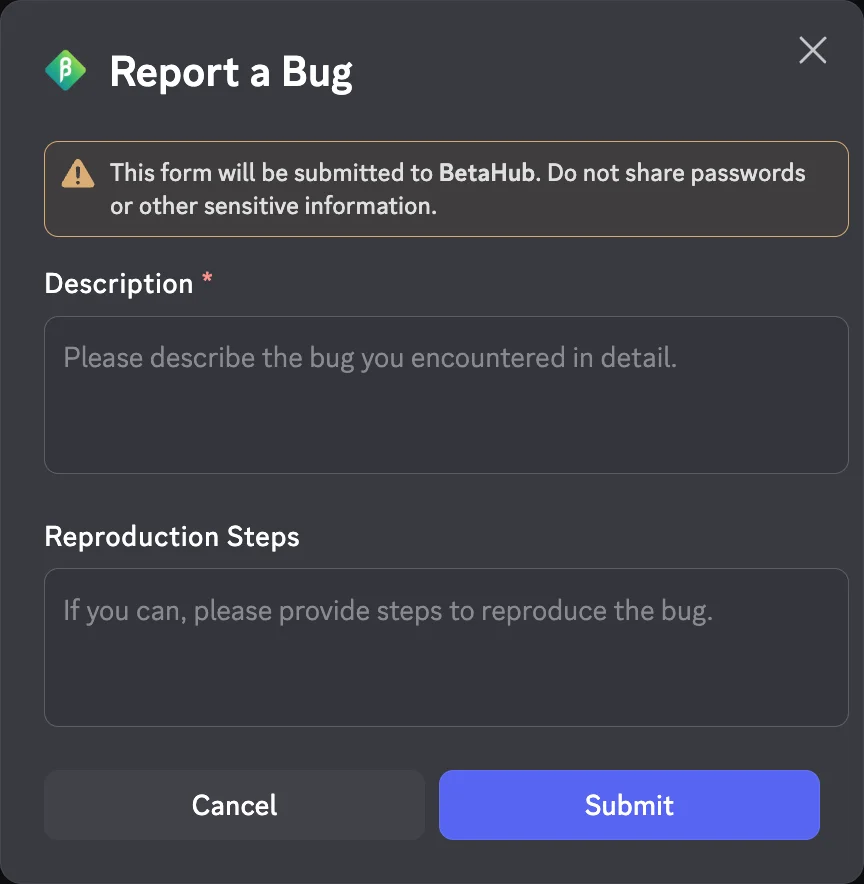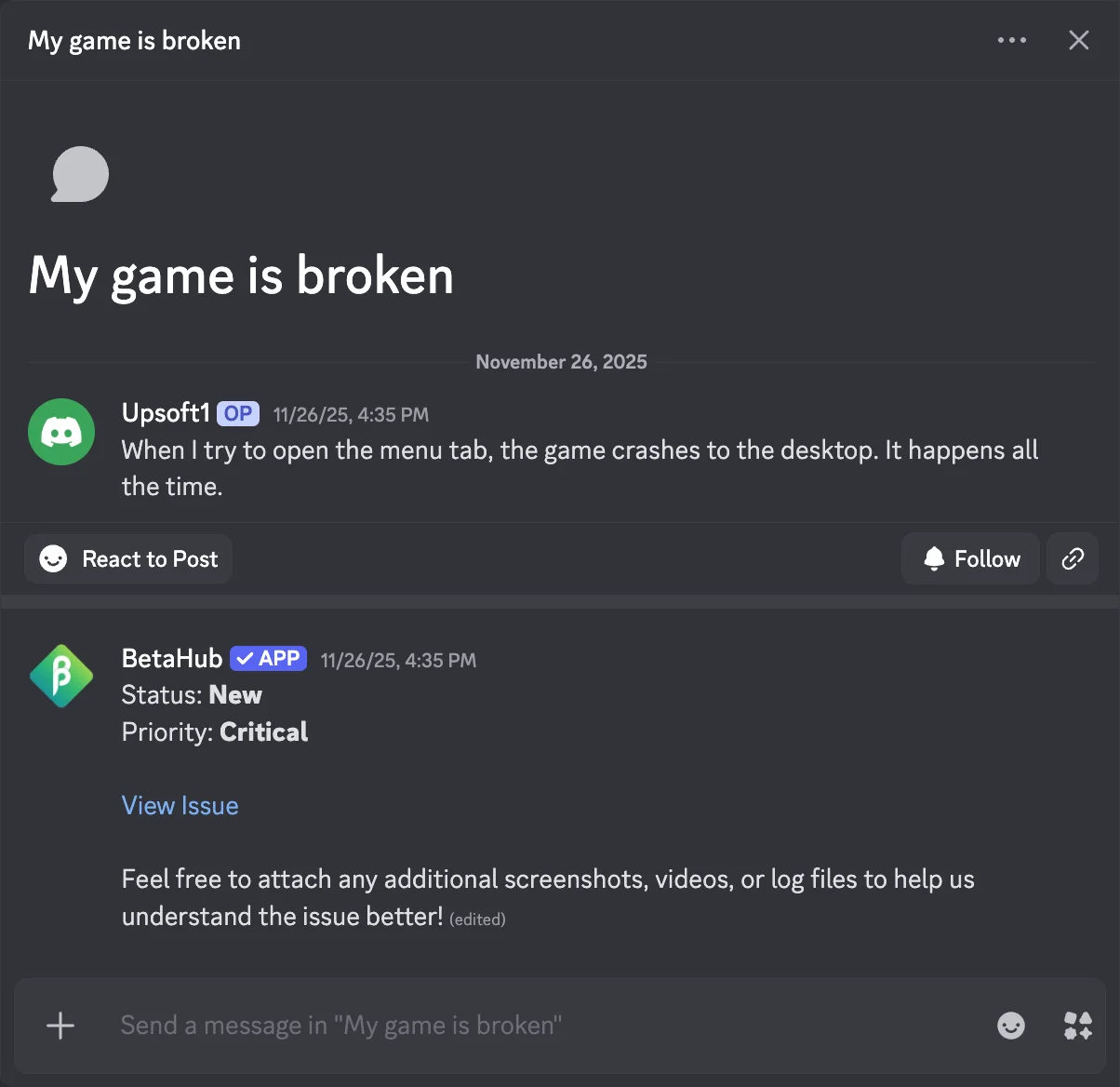Features
BetaHub helps you collect and manage feedback from your game’s community.
Feedback Collection
Testers can submit bugs and suggestions through:
- Discord –
/reportand/suggestcommands, forum channels, or automatic detection from chat - In-game – Unity and Unreal plugins with automatic screenshots and video
- Web forms – Embeddable widget or direct submission on BetaHub
All submissions are processed automatically:
- Generates clear titles from descriptions
- Assigns priority based on severity
- Detects duplicates and links related reports
- Applies tags based on your game’s systems

Feedback Management
Issues (Bugs)
Track bugs through a complete lifecycle:
New → In Progress → Needs More Info → Resolved → Closed
Key capabilities:
- Heat scoring – Duplicates and watchers increase priority automatically
- Duplicate detection – Similar reports are linked together
- Custom fields – Collect project-specific data (game version, platform, etc.)
- Auto-archiving – Inactive issues archived automatically to keep lists clean

Suggestions
Let your community propose and vote on ideas:
- Public voting and comments (no account required to view)
- Status tracking: Open → Under Review → Planned → Completed
- Tag organization for roadmap planning
- Link duplicate suggestions together

Managing feedback as a developer →
Discord Integration
Turn your Discord server into a feedback hub:
| Command | Purpose |
|---|---|
/report |
Submit a bug report |
/suggest |
Submit a feature request |
/ticket |
Open a support ticket |
/ask |
Get answers from your knowledge base |
/install |
Interactive setup wizard |
Automation features:
- Listen Mode – AI detects feedback in chat and offers to submit it
- Forum integration – Automatically creates issues from forum threads
- Thread mode – Creates discussion threads for each report (public or private)
- Two-way sync – Status changes and comments sync between Discord and BetaHub
Additional capabilities:
- Release announcements when you ship new versions
- Welcome messages for new server members
- Roblox user verification (via Bloxlink or RoVer)
- Custom fields in submission dialogs
- Clickable buttons for bug reports, suggestions, and instant help
Full Discord Bot documentation →

Game Engine Plugins
Capture rich context automatically with in-game reporting:
- Screenshots – Capture and annotate the exact moment
- Video replay – Record gameplay leading up to the issue
- Log files – Attach engine logs automatically
- System info – Hardware specs, OS, game version
Supported engines:
- Unity (including WebGL)
- Unreal Engine
Game engine integration guide →
External Integrations
Connect BetaHub to your existing workflow:
Project Management:
- Jira, Asana, GitHub, Linear, ClickUp, Notion
Notifications:
- Webhooks for Slack, Teams, or custom tools
API:
- REST API with personal access tokens
- Webhook events for automation
See all integrations → · Webhook setup → · API access →
AI Capabilities
BetaHub uses AI throughout the platform:
| Feature | What it does |
|---|---|
| Title generation | Creates clear titles from user descriptions |
| Priority assignment | Sets priority based on severity and game context |
| Duplicate detection | Links similar reports automatically |
| Tag suggestions | Categorizes based on your tag structure |
| Support answers | Responds to common questions from your knowledge base |
Support Knowledge Base
Build a knowledge base so AI can answer common questions automatically:
- Upload documentation (PDF, TXT, MD) or convert bug comments into articles
- AI searches your knowledge base before creating tickets
- Works in Discord (
/askcommand, bot @mentions) and web forms - Track which questions aren’t covered with knowledge gaps analysis
Game Facts
Tell the AI about your game to improve accuracy:
- Game genre and core mechanics
- Critical vs. non-critical systems
- Custom terminology and jargon
- Priority rules specific to your project
Community Insights
Understand your community beyond individual bug reports.
Sentiment Analysis
Track how your community feels over time:
- Mood dashboard – See sentiment trends across channels
- Category breakdown – Excited, Positive, Neutral, Negative, Frustrated
- Top words – Identify what players are talking about
- Discussion topics – Auto-organize conversations by theme
Configure Sentiment Analysis →
Activity Feed
See everything happening in your project:
- Chronological log of all actions (submissions, status changes, comments)
- Filter by activity type, user, or date
- Track automated actions (Discord Bot, game form submissions)
- Available project-wide and per-issue
Learn more about Activity Feed →
Multimedia Support
Testers can attach rich media to any submission:
| Type | Formats | Max Size |
|---|---|---|
| Screenshots | PNG, JPG, JPEG | 10 MB |
| Videos | MP4, MOV, WEBM, AVI | 500 MB |
| Log files | TXT, LOG | 50 MB |
Screenshots include an annotation editor for highlighting issues.
Notifications
Stay informed about project activity:
- Email – Configurable alerts for new bugs, status changes, comments
- Discord DM – Direct messages from the bot
- Web – In-app notification center
Configure per-project notification preferences in your profile settings.
Pricing
BetaHub offers plans for solo developers through large studios. Features like video recording duration, custom fields, and sentiment analysis vary by plan.
Next Steps
Choose your path:
For Developers:
- Getting Started – Set up your first project
- Project Setup – Configure roles, tags, and settings
- Integration Setup – Connect game engines and Discord
For Testers:
- Joining Projects – Find and join games to test
- Submitting Feedback – Report bugs and suggestions effectively
Reference:
- Quick Reference – Status tables, file formats, specifications
- Discord Bot – Complete Discord integration guide
- Advanced Features – Sentiment analysis, knowledge base, activity feed
- Account & Settings – Organizations, API access, security